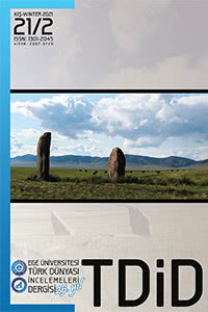Serbian folk narratives concerning fate and their Turkish parallels
Kaderle ilgili Sırp halk anlatmaları ve Türklerdeki paralelleri
___
- AARNE, Antti; Thompson, Stith The Types of the Folktale (second revision), FF Communications, 184, Helsinki 1961.
- ABDULLAEYV, A.„Mythological Image of Alarvady (Albasty) in the Azerbeijan Birth Rites“, Folk Belief Today Tartu 1995, pp.17-22. Today,
- BRAJAKTAREVIĆ, Mirko, Nasredin-hodžin problem Beograd 1934. Nasredin- problem,
- BORATAV, Pertev Naili, Contes Turcs (Contes des cinq continents), Paris 1955.
- BOŠKOVIĆ-STULLI, Maja, Zakopano zlato. Hrvatske usmene pripovijetke, predaje i legende iz Istre, Pula-Rijeka 1986.
- BÖTHLINGK, Otto, Sanskrit-Chrestomatie Leipzig 1906. Sanskrit-Chrestomatie,
- BOVAN, Vladimir , Narodne pripovetke i umotvorine sa Kosova i Metohije. Studentski zapisi srpskih narodnih umotvorina sa Kosova i Metohije, Priština 2005.
- BREDNICH, Rolf-Wilhelm, Volkserzählung und Volksglaube von den Schicksalsfrauen Volksglaube Schicksalsfrauen. FFC 193, Helsinki 1964.
- BRUNNER, Helmut, Grundzuge einer Geschichte der altägyptischen Literatur Darmstadt, Literatur, 1966.
- COHEN-MOR, Dalya, A Matter of Fate: The Concept of Fate in the Arab World as Reflected Literature rature, in Modern Arabic Literature Oxford University Press 2001.
- COSQUIN, Emmanuel, Les contes indiens et le occident Paris 1922. occident,
- ĐORĐEVIĆ, Tihomir, Naš narodni život VI, Beograd 1932.
- ĐORĐEVIĆ, Dragutin, Narodne pripovetke i predanja Leskovačke oblasti Beograd, 1988. oblasti,
- EBERHARD, Wolfgang; BORATAV, Pertev Naili, Typen türkischer Volksmärchеn, Volksmärchе Wiesbaden 1953.
- EL-SHAMY, Hasan, Folk Tales of the Arab World: a guide to motif clasification Volume 1, clasification, 1995.
- EL-SHAMY, Hasan, A Motif Index of The Tousand and One Night Bloomington and Night, Indianapolis 2006.
- EL-SHAMY, Hasan, Religion Among the Folk in Egypt Praeger 2008. Egypt,
- ERMAN, Adolf, Die Literatur der Aegypter, Leipzig 1923 . Aegypter
- FRIENDLY by Narayana, trans.by J.Törzsök, (Clay Sanskrit Library), New York University Press, JJC Foundation 2007. muzeja,
- GEM = Glasnik Etnografskog muzeja VII, 1933, pp.110-111.
- GIESE, Friedrich, Türkische Märchen Die Märchen der Weltliteratur, Jena 1925. Märchen,
- GRUDLINSKI, Stephan. „Vergleichende Untersuchungen und Charakteristik der Sage vom Findelkind das später Kaiser wird“. Zeitschrift für romanische Philologie 36 (1912) Zeitschrift
- HITOPADEŚA by Bhaţţa Nârâyaņa, ed.by M.D.Apte, Poona 1957.
- HORALEK, Karel, „Prilog tipologiji pripovedaka Vukove zbirke“, Rad 11. kongresa Saveza 1964, folklortsta Jugoslavije u Novom Vinodolskom 1964 Zagreb 1966.
- JAGIĆ, Vatroslav, Historija književnosti naroda hrvatskoga i srpskoga. Knjiga prva – staro knjiž srpskoga. doba, doba Zagreb 1867.
- KENT, E, „What ’s Written on the Forehead Will Never Fail. Karma, Fate and Headwriting in Indian Folktales“, Asian Ethnology 68, 1, 2009, pp.1-26.
- LEYEN, Friedrich von der, „Ägypten“ ,Enzyklopädie des Märchens 1, Berlin-New York Enzyklopädie 1975.
- MARZOLPH, Ulrich; VAN LEEUWEN, R. The Arabian Nights Encyclopedia Vol.1, Santa Barbara, Denver, Oxford 2004.
- MILIĆEVIĆ, Milan Đ. Kneževina Srbija Beograd 2005. Srbija,
- MILOŠEVIĆ-ĐORĐEVIĆ, Nada, Zajednička tematsko-sižejna osnova srpskohrvatskih tematsko- tadicije, neistorijskih pesama i prozne tadicije Beograd 1971.
- MONIER-WILLIAMS, Monier, Brahmanism and Hinduism or Religious Thought and Life in India, London 1891.
- OZTURKMEN, A. “From Constantinople to Istanbul: Two Sources on the Historical Folklore of a City“, Asian Folklore Studies, 61, 2002, pp. 271-294. Studies
- RESSEL, Svetlana, Orientalisch-osmanische Elemente im balkanslavischen Volksmärchen Orientalisch- Volksmärchen, (Studia slavica et Baltica 2), Münster 1981.
- ROUX, Jean-Paul= RU, Žan Pol, Religija Turaka i Mongola (J.P. Roux, La religion des Turcs Mongols, et des Mongols trans. by M. Perić-Marjanov), Sremski Karlovci-Novi Sad 2002.
- ŠOP, Ivan, Nasredinove metamorfoze Beograd 1973.
- THE PANCATANTRA ed. R.Jha, Varanasi 1991.
- THOMPSON, Stith, The Folktale New York 1946. Folktale,
- THOMPSON, Stith, Motif Index of Folk Literature, Bloomington 1957. Literature
- THOMPSON, Stith; BALYS, Jonas, The Oral Tales of India Indiana University Press 1958. India,
- TRUHELKA, Ćiro, Arnautske priče. Niz primjera arnautske narodne poezije iz izvornog govora pribrane i priregjene II, Sarajevo 1905.
- UTHER, Hans Jörg, The Types of International Folktales. A classification and Bibliography. Based on the System of Antti Aarne and Sith Thompson, Part I (Animal Tales, Tals Magic, of Magic, Religious Tales, and Realistic Tales, with an Introduction), FFC 284, Helsinki 2004.
- UYSAL-WALKER ARCHIVE (http://aton.ttu.edu )
- VETALAPAÑCAVIМŚАТI, in: Kathāsaritsāgara, ed. Jagadīś Lāl Śāstri, Delhi 1970. VETALAPAÑCAVIМ АТI, Kathāsaritsāgara ИНДУИЗМА,
- БОГИ, БРАХМАНЫ, ЛЮДИ. ЧЕТЫРЕ ТЫСЯЧИ ЛЕТ ИНДУИЗМА Москва 1969.
- ВЕРКОВИЌ, Стефан , Македонски народни умотворби 4, Скопје 1985.
- ДАСКАЛОВА-ПЕРКОВСКА, ДОБРЕВА, КОЦЕВА, МИЦЕВА, Български фолклорни фолклорни приказки. Каталог, София: Университетско издателство „Св.Климент Каталог Охридски“ 1994.
- СЕДАКОВА, Олга , Балканские мотивы в языке и културе болгар Москва 2007.
- ISSN: 1301-2045
- Yayın Aralığı: 2
- Başlangıç: 1996
- Yayıncı: Ege Üniversitesi Türk Dünyası Araştırmaları Enstitüsü
BALKAN SAVAŞLARI SIRASINDA IRASINDA ARAPLARIN TUTUMU 1912-1913∗
Serbian folk narratives concerning fate and their Turkish parallels
Mehmet DALKILIÇ, Ramazan BİÇER, Ekrem DEMİRLİ
XIX. YÜZYIL SEYAHATNAMELERİNDE VE ASKERİ ANLATILARINDA TÜRKMENLERE ATFEDİLEN ATASÖZLERİ
Osmanlı Arşivinde Tuna Nehri ve Kıyıları
THE TIMES GAZETESİ’NE GÖRE BALKAN SAVAŞLARI VE İNGİLTERE’NİN POLİTİKASI
